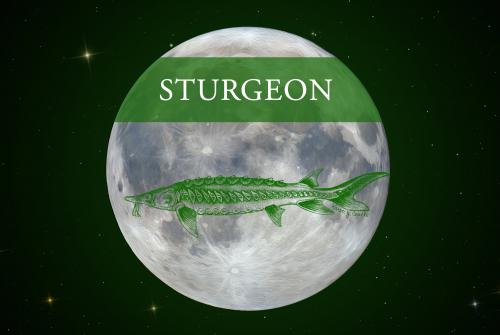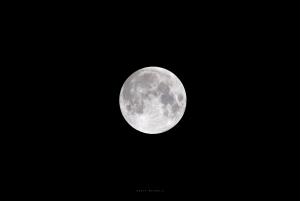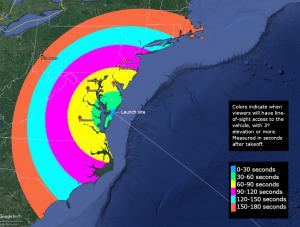Celebration of Space - July 28, 2023
This coming Tuesday, August 1, 2023, at 2:33 pm ET, the Moon will orbit into a position where it arrives on the opposite side of Earth than the Sun, keeping the Moon in full sunlight all night long. This is the full Moon, but more scientifically it is referred to as opposition. Just like star lore, humans historically love to name things, and the Moon is certainly no exception. The August full Moon is named The Full Sturgeon Moon, which relates to the big fish that were historically caught in the Great Lakes and Lake Champlain. Other names that the August Moon has been referred to are: The Green Corn Moon, Black Cherries Moon, and The Mountain Shadows Moon.
Did you know that the August full Moon is also a Perigee-Syzygy (aka supermoon)? The supermoon is such a hyped up term in modern media publications and the definition seems to change every year. It is often accompanied with terms like “rare” and “stunning”, but all of that is nonsense. Supermoons happen every year, so they are not rare, and an observer will not notice the difference in brightness or size. Additionally, everyone seems to keep extending the time gap between perigee and the full Moon to allow for additional supermoons every year. Let’s address this.
Like all objects that orbit other objects, there is deviation from a perfect circular orbit, called eccentricity, which will result in a closest point (perigee) and a furthest point (apogee) that the object will have from the body it orbits. This applies to the Moon as well. During the Moon’s 27.3 day orbit around Earth, there will be a perigee and an apogee. Generally, a supermoon happens when the full Moon occurs within 24 hours of perigee, which is already a rather loose determination. During this time the full Moon will appear a bit brighter and a bit larger than when the full Moon occurs near lunar apogee, which usually happens in the January time frame. In reality the appearance of brightness in the Moon is more related to how high the Moon is in the sky, the conditions of Earth’s atmosphere both globally and locally, and your viewing location.
Regardless of how you feel about the supermoon, it is still a full Moon, and the August full Moon hails the coming autumn season in the Northern Hemisphere. Additionally, in August 2023 we will have two full Moons, with the second occurring on August 30, 2023, and by some definitions, that will be a Blue Moon, but we’ll write about that later this August. In the meantime, be sure to step outside this coming Monday evening around 9:00 pm, and look to the SSE horizon to catch the Full Sturgeon Moon of August rising.
On July 14, 2023, the annual Perseid Meteor Shower kicked in. Referred to as the Perseids, this is one of the best meteor showers of the year. Though the peak night, which is when the best display of shooting stars will happen, does not occur until overnight August 12-13, Perseid meteors are becoming more frequent with each passing night. One of the reasons the Perseid shower appears to be so active is that there are two other notable meteor showers that occur at the same time with the Perseids. The first is the Southern Delta Aquariids, which is better for viewers in the Southern Hemisphere, but still quite a good shower for all of us up north. The second is the Alpha Capricornids. The Delta Aquariids will peak overnight on July 30-31 and can bring an increase of 25 meteors per hour to the sky. The Capricornids will peak on the same night, bringing an increase of about 5 meteors per hour. It should also be noted that the Capricornid shower is known to bring bright fireball meteors to the sky, and in 2023, the shower has not been disappointing. The Moon is moving towards the full phase right now, which will make for poor meteor watching conditions, but once that Moon departs, we are back in action. So gear up for some awesome meteor watching this August.
Just before stepping out to catch that stunning view of the August full Moon rising on Tuesday, August 1, 2023, you may just score a view of the Antares rocket carrying the cargo resupply mission to the International Space Station (ISS). At 8:31 pm ET, the launch window opens for the Antares rocket to launch from Wallops Island, VA, a launch that will be visible for Southern New England sky watchers. All of Rhode Island is set for a 3 second delay before the launch vehicle should become visible. To view, be at a location with a good view of the southern horizon, and be there before 8:30 pm. The launch vehicle will look like a fast moving star, and due to the launch time coinciding with dusk, the exhaust plumes may be visible as well. Here is a visibility chart from Wallops. Let us know if you see it!
Tuesday, August 1, 2023 is also Lammas, which is a cross quarter day. It seems like this coming Tuesday is just the day this year! Cross quarter days are the midpoints between the Solstice and the Equinox. After Tuesday, we are closer to the Autumnal Equinox than we are to the past Summer Solstice. Other cross quarter days are Halloween, Groundhog Day, and May Day. So make the best of summer, because we are now in the second half.
After a rather long period of evening ISS passes over our region, the fun is coming to an end. The last evening pass of the ISS for the current viewing period will occur on Tuesday, August 1, 2023. Even though evening passes are coming to an end for the remainder of summer break, the view will go out with a bang as there are a couple of fantastic viewing opportunities this weekend:
Fri, Jul 28 at 9:03 pm, starting in the NW, rising to 55°, heading towards the ESE, and into orbital sunset ← Awesome pass!
Sat, Jul 29 at 9:51 pm, starting in the WNW, rising to 30°, and into orbital sunset
Sun, Jul 30 at 9:02 pm, starting in the WNW, rising to 53°, heading towards the SE, and into orbital sunset. ← Awesome pass!
Tue, Aug 1 at 9:02 pm, starting in the W, rising to 19°, heading towards the S
Note that these times are applicable to Southern New England and are acceptable for the Northeast. For daily pass times of the ISS and other bright satellites, visit the Frosty Drew Daily Satellite Pass Prediction Utility.
- Author:
- Scott MacNeill
- Entry Date:
- Jul 28, 2023
- Published Under:
- Scott MacNeill's Columns






